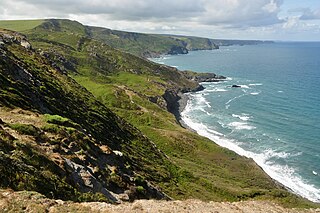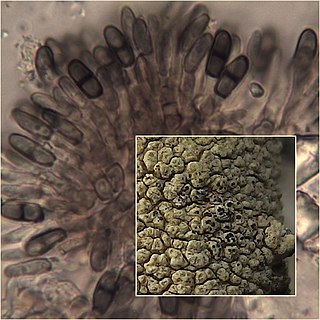
A lichen is a composite organism that arises from algae or cyanobacteria living among filaments of multiple fungi species in a mutualistic relationship. Lichens have properties different from those of their component organisms. They come in many colors, sizes, and forms and are sometimes plant-like, but are not plants. They may have tiny, leafless branches (fruticose); flat leaf-like structures (foliose); grow crust-like, adhering tightly to a surface (substrate) like a thick coat of paint (crustose); have a powder-like appearance (leprose); or other growth forms.

The Eurasian coot, also known as the common coot, or Australian coot, is a member of the rail and crake bird family, the Rallidae. It is found in Europe, Asia, Australia, New Zealand and parts of North Africa. It has a slaty-black body, a glossy black head and a white bill with a white frontal shield. The sexes are similar. Similar looking coot species are found throughout the world, with the largest variety of coot species living in South America.

Cladonia is a genus of moss-like lichens in the family Cladoniaceae. They are the primary food source for reindeer/caribou. Cladonia species are of economic importance to reindeer-herders, such as the Sami in Scandinavia or the Nenets in Russia. Antibiotic compounds are extracted from some species to create antibiotic cream. The light green species Cladonia stellaris is used in flower decorations.

The Parmeliaceae is a large and diverse family of Lecanoromycetes. With over 2700 species in 71 genera, it is the largest family of lichen-forming fungi. The most speciose genera in the family are the well-known groups: Xanthoparmelia, Usnea, Parmotrema, and Hypotrachyna.

The black flying squirrel or large black flying squirrel is a species of rodent in the family Sciuridae. It is found in Brunei, Indonesia, and Malaysia; its habitat is primary and secondary forests and gardens where it uses tree hollows. It feeds on fruits, nuts and other vegetable matter. It is likely not threatened and is adaptable to habitat loss. Black flying squirrels tend to have smaller populations than other squirrels because female black flying squirrels breed infrequently and have a small litter size of just one young.

Calvitimela is a lichen genus in the family Tephromelataceae. Members of the family Tephromelataceae are crustose lichens with green photobionts and lecideine or lecanorine apothecia. The species in Calvitimela have lecideine apothecia, are saxicolous and are primarily found in alpine to arctic regions.

Boscastle to Widemouth is a coastal Site of Special Scientific Interest (SSSI) in Cornwall, England, noted for its biological and geological characteristics. The Dizzard dwarf oak woodland is unique and of international importance for its lichen communities, with 131 species recorded.

Tephromela is a genus of lichens in the family Tephromelataceae. There are about 25 species in this widespread genus.

Lecanora argopholis is a species of crustose lichen in the family Lecanoraceae. It was originally named Parmelia atra var. argopholis by Erik Acharius in 1803, then transferred by him to the genus Lecanora in 1810. The lichen has a circumpolar distribution.

Haematomma ochroleucum, also known as yellow bloodstain lichen, is a species of crustose lichenized fungus. First described in 1771 by Noël Martin Joseph de Necker, it has no subspecies, but two named varieties: H. o. var. ochroleucum and H. o. var. porphyrium.

The Tephromelataceae are a family of lichenized fungi in the order Lecanorales. The family was circumscribed by Austrian lichenologist Josef Hafellner in 1984. Tephromelataceae comprises the genera Tephromela, Calvitimela, Mycoblastus and Violella, which together constitute a well-supported monophyletic group.
Thomas Hawkes Nash III is an American lichenologist. His research is about the biology and ecology of lichens, and the effects of air pollution on plants and lichens. He is known as an authority on the family Parmeliaceae. During his long career at the Arizona State University, he helped develop the lichen herbarium into a world-class collection with over 100,000 specimens representing more than 5000 species. In 2010, the year of his retirement, he was awarded the Acharius Medal for lifetime achievements in lichenology, and the following year had a Festschrift published in his honor.

Muellerella pygmaea is a species of lichenicolous fungus in the family Verrucariaceae. It has a cosmopolitan distribution in Arctic-alpine areas and grows on the thallus and apothecia of a number of hosts.
Atrophysma is a genus in the family Pannariaceae. It contains the single species Atrophysma cyanomelanos, a crustose lichen found only in Alaska.
Caloplaca tephromelae is a species of lichenicolous (lichen-eating) lichen in the family Teloschistaceae. Found in Australia, it was formally described as a new species in 2021 by Gintaras Kantvilas, Ave Suija, and Jurga Motiejūnaitė. The type specimen was collected from the northern rim of Callitris Gully ; here it was found growing on the thallus of the lichen Tephromela atra, which itself was growing on dolerite outcrops. Caloplaca tephromelae is only known to occur at the type locality. It appears as whitish areolate sections, outlined by a dark band of prothallus, growing within the thallus of its host lichen. Another recorded host is Tephromela granularis. The specific epithet tephromelae refers to the genus of the host.
Degelia neozelandica is a species of foliose lichen in the genus Degelia.
Tephromela lignicola is a species of lignicolous (wood-dwelling), crustose lichen in the family Tephromelataceae. It is found in the Falkland Islands, where it grows on fenceposts and similar timber.

Minutoexcipula is a genus of lichenicolous (lichen-dwelling) fungi of uncertain familial placement in the order Chaetothyriales. It has eight species. The genus was circumscribed in 1994 by M. Violeta Atienza Tamarit and David Leslie Hawksworth, with Minutoexcipula tuckerae assigned as the type species. The genus is characterized both by its black convex sporodochia-like conidiomata, as well as the well-differentiated exciple on these structures.












